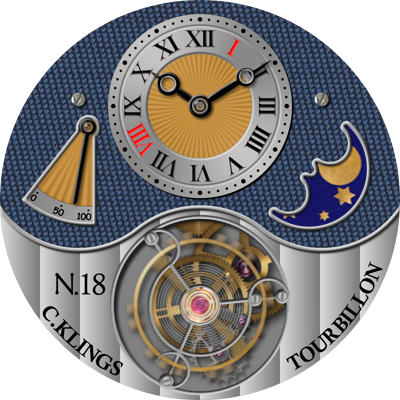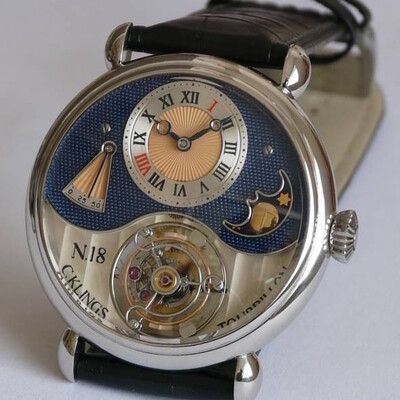Christian Klings is an independent watchmaker from Germany. He has already made a number of really impressive watches. One of these watches particularly impressed me: the Tourbillon No.18.
The central part of the dial is made of silk fabric. The one-minute tourbillon is hand-wound. I repurposed the power reserve display to show the battery level.
Since C.Klings is relatively unknown, only a few pictures of this watch were available. Since the quality of these images was not sufficient for a good watch face, I reproduced it completely in the drawing program. The tourbillon in particular kept me busy for a while.
Enjoy and have fun.
Credits: -https://www.christianklings.com/
Download: -kling.zip - Google Drive


10 Likes
Worth the wait. Superb mate 
1 Like
Thank you, mate. It was a lot of work. Have you noticed that even the reflection of the light on the chrome rings of the hands follow the light?
1 Like
Without question, one the of the most spectacular restorations I’ve yet to see… Well done @G1NT0N1C
Thank you, @pablo11 . It was a lot of work.
1 Like
Beautiful watch and clockskin! I am most impressed that you reproduced the images completely in a drawing program. I have absolutely no idea how to create a homage watch face without a good image to work with! (Or perhaps I should say I lack the necessary skills and knowledge to do that.)
2 Likes
Thank you. My approach is as follows: First of all, I look for some images. the higher the resolution, the better. Then I enlarge this to around 6000×6000 pixels. I tilt, rotate and stretch these images so that I get the roundest possible result, which I then cut out and reduce to exactly 4000×4000 pixels. Ideally, I have around 3 such images, which I then place on top of each other on three different levels.
I now put together a base from these. Once this work is done, I will move some individual parts if necessary.
Once this work is done I can begin to recreate each individual part based on the template. By the way, I always create watch faces in the 4000×4000 format, as this allows for more precise work. Only when everything is finished do I reduce the size to 400×400 to put the individual components together in WFD.
3 Likes
Oh, now I understand. I assume you use three levels because each may have hands (obstructions) at different spots so you can combine the unobstructed parts into one? That’s interesting, I’ve never done that. I look for the best starting image I can find, rotate and stretch as needed as you described, then I remove all the moveable parts (hands, moons, gears, etc.) for separate use, then go through the laborious process of repairing all of the missing areas of the base dial, with a lot of copying and pasting and rotating and resizing and painting until I’m satisfied (or until I’ve reached my limit in ability or diligence). As you do, I downsize the images at the end if needed.
1 Like
What size do you use for image editing?
I will use whatever resolution the source image is. I don’t upsize it or downsize it, until downsizing later in the process after all the image editing is done. I look for a source image with good enough resolution, as high as possible.
1 Like

